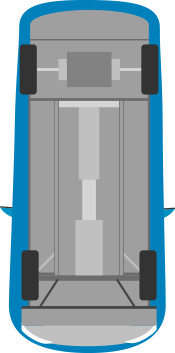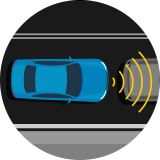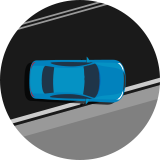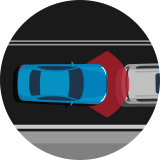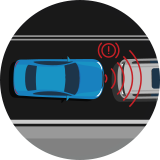Ratings
Search vehicle safety ratings.
NHTSA's 5-Star Safety Ratings help consumers make smart decisions about safety
when purchasing a vehicle. You can also search ratings by manufacturer.
Check your car seat's Ease of Use Ratings.
NHTSA’s Ease of Use Ratings let you compare how easy it is to use certain car seat features so you can make an informed decision about the right car seat.
Go to Car SeatsCheck your tires.
Uniform Tire Quality Grading Systems (UTQGS) ratings allow
consumers to compare tire features.
Buying a new car?
Purchase a vehicle with safety in mind. Use NHTSA's Vehicle Comparison Tool to see 5-Star Safety Ratings and recall information at a glance.
Frequently Asked Questions
The National Highway Traffic Safety Administration’s New Car Assessment Program (NCAP) created the 5-Star Safety Ratings program to provide consumers with information about the crash protection and rollover safety of new vehicles beyond what is required by federal law. One star is the lowest rating; five stars is the highest. More stars equal safer cars.
We have a list of the model year 2025 vehicles selected for crash testing under NHTSA's 5-Star Safety Ratings program.
Yes, other organizations crash test vehicles, but NHTSA is the only organization that rates rollover resistance in addition to frontal and side crashworthiness.
NHTSA categorizes vehicles by class and “curb” weight. Curb weight is the weight of a vehicle with standard equipment including the maximum capacity of fuel, oil, coolant, and air conditioning. Passenger cars are further subdivided.
- Passenger cars mini (PC/Mi) (1,500–1,999 pounds)
- Passenger cars light (PC/L) (2,000–2,499 pounds)
- Passenger cars compact (PC/C) (2,500–2,999 pounds)
- Passenger cars medium (PC/Me) (3,000–3,499 pounds)
- Passenger cars heavy (PC/H) (3,500 pounds and over)
- Sport utility vehicles (SUV)
- Pickup trucks (PU)
- Vans (VAN)
Side crash rating results can be compared across all classes because all vehicles are hit with the same force by the same moving barrier or pole.
Rollover ratings can also be compared across all classes.
Frontal crash rating results can only be compared to other vehicles in the same class and whose weight is plus or minus 250 pounds of the vehicle being rated. This is because a frontal crash rating into a fixed barrier represents a crash between two vehicles of the same weight.
The symbol ⚠ alerts consumers to a safety concern the government has about the vehicle. That concern can include: structural failure or some type of unintended performance of a vehicle component such as a fuel leakage or a door opening. Please note that safety concerns are not part of the calculation for an Overall Vehicle Score. A vehicle can have a high star rating, but still have a safety concern. However, if a safety concern is identified, the symbol will appear in the correct crash category and Overall Vehicle Score area.
Yes, NHTSA is constantly evaluating its New Car Assessment Program for updates. NHTSA prioritizes updates that have the greatest safety impact. NHTSA uses four prerequisites when considering updates to the program.
- Does the update address a significant safety need?
- Do vehicle designs exist for the update?
- Does the update have the potential to improve safety?
- Does an objective test procedure exist for the update
Once the prerequisites for an update are met, NHTSA begins the updating process.
- Request for comments notice published in the Federal Register
• Solicits comments on a detailed proposal - Receipt of public comments
• Public submits comments to NHTSA - Comments resolution process
• NHTSA considers comments
• Conducts additional research, if needed - Is a supplemental public notice/request for comments needed?
• If yes, repeat process and begin with step 1
• If no, move to step 5 - Final decision notice published in the Federal Register
• NHTSA responds to public comments
• Final decision detailed, including lead time for changes and implementation
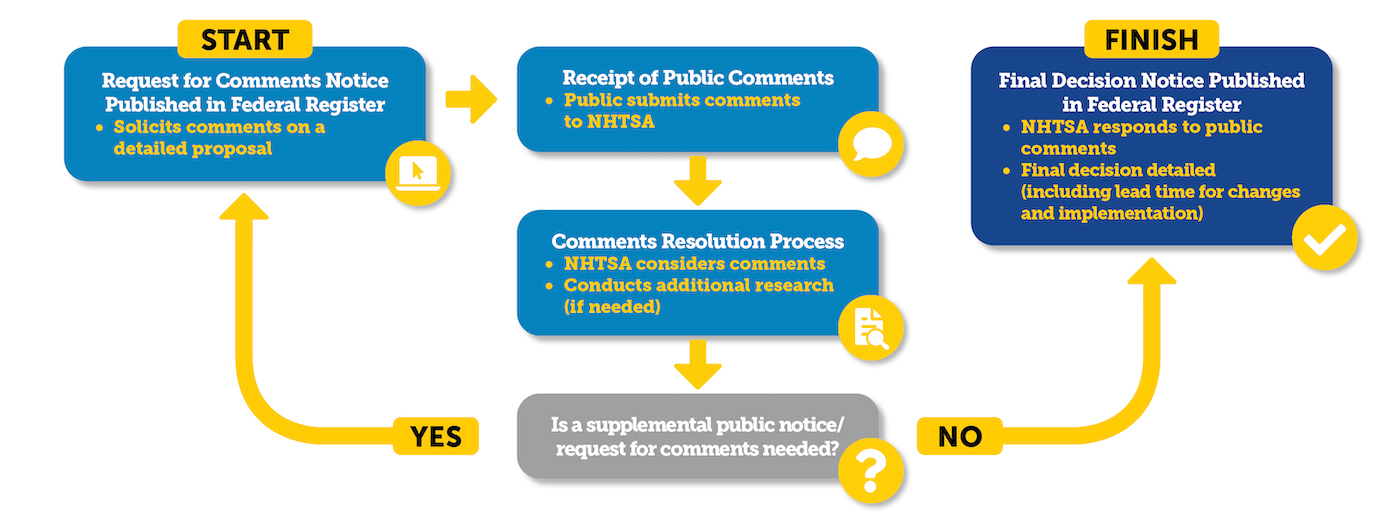
For the frontal crash tests, crash dummies representing an average-size adult male and a small-size adult female are placed in the driver and front passenger seats, respectively, and are secured with the vehicle's seat belts. Vehicles are crashed into a fixed barrier at 35 miles per hour (mph), which is equivalent to a head-on collision between two similar vehicles each moving at 35 mph. Since the rating reflects a crash between two similar vehicles, make sure you compare vehicles from the same weight class, plus or minus 250 pounds, when looking at frontal crash star ratings and Overall Vehicle Scores.
Instruments measure the force of impact to each dummy's head, neck, chest, pelvis, legs, and feet. Frontal star ratings indicate the chance of a serious head, neck, chest, and leg injury to the driver and right front seat passenger in a frontal crash. A serious injury is one requiring hospitalization. Star ratings for the driver and passenger in a frontal crash test are assigned as follows:
⭐⭐⭐⭐⭐= less than 10% chance of serious injury
⭐⭐⭐⭐= 10% to 15% chance of serious injury
⭐⭐⭐= 15% to 20% chance of serious injury
⭐⭐= 20% to 40% chance of serious injury
⭐= greater than 40% chance of serious injury
The overall frontal star rating is assigned according to the chart below:
⭐⭐⭐⭐⭐= Frontal crash injury risk in this vehicle is much less than average
⭐⭐⭐⭐= Frontal crash injury risk in this vehicle is less than average to average
⭐⭐⭐= Frontal crash injury risk in this vehicle is average to greater than average
⭐⭐= Frontal crash injury risk in this vehicle is greater than average
⭐= Frontal crash injury risk in this vehicle is much greater than average
For the side barrier crash tests, crash dummies representing an average-size adult male and a small-size adult female are placed in the driver and rear passenger seats (driver's side), respectively, and are secured with the vehicle's seat belts. The side crash rating represents an intersection-type collision with a 3,000-pound barrier moving at 38.5 mph into a standing vehicle. The moving barrier is covered with material that has "give" to replicate the front of a vehicle. Since all rated vehicles are impacted by the same size barrier, it is possible to compare all vehicles with each other when looking at side barrier crash protection ratings.
Instruments measure the force of impact to each dummy's head, neck, chest, lower spine, abdomen, and pelvis. Side barrier star ratings indicate the chance of a serious head, chest, abdomen, and pelvis injury for the driver and front seat passenger (outboard first row occupants), and the chance of serious head and pelvis injury for the rear seat passengers (outboard second row occupants). A serious injury is one requiring hospitalization. It may result in a permanent disability or in some cases be life-threatening.
Lower spine injury, although measured, is not currently included in the star rating. Excessive lower spine injury readings (lower spine reading greater than 82 Gs) are reported separately. For the front seat occupants, they are reported as a footnote on NHTSA.gov, and for the rear passenger occupants, they are reported separately as a safety concern. Star ratings for front and rear seat occupants in the side barrier crash test are assigned as follows:
⭐⭐⭐⭐⭐= less than 10% chance of serious injury
⭐⭐⭐⭐= 10% to 15% chance of serious injury
⭐⭐⭐= 15% to 20% chance of serious injury
⭐⭐= 20% to 40% chance of serious injury
⭐= greater than 40% chance of serious injury
The overall side barrier star rating is assigned according to the chart below:
⭐⭐⭐⭐⭐= Side barrier crash injury risk for this vehicle is much less than average
⭐⭐⭐⭐= Side barrier crash injury risk for this vehicle is less than average to average
⭐⭐⭐= Side barrier crash injury risk for this vehicle is average to greater than average
⭐⭐= Side barrier crash injury risk for this vehicle is greater than average
⭐= Side barrier crash injury risk for this vehicle is much greater than average
For the side pole crash test, a crash-rating dummy representing a small-sized adult female is placed in the driver’s seat and is secured with the vehicle's seat belt. During a side pole crash test, a vehicle strikes a 25 cm diameter pole at a 75-degree angle at 20 mph. The pole mimics narrow fixed objects like utility poles and trees that are often involved in side crashes. Since all rated vehicles impact the same size pole, it is possible to compare all vehicles with each other when looking at side pole crash protection ratings.
Instruments measure the force of impact to the dummy's head, neck, chest, lower spine, abdomen, and pelvis. Side pole star rating indicates the chance of serious head and pelvis injury for the driver (outboard first row occupants). A serious injury is one requiring hospitalization. It may result in a permanent disability or in some cases be life-threatening.
Lower spine injury, although measured, is not currently included in the star rating. Excessive lower spine injury readings (lower spine reading greater than 82 Gs) are reported separately as a safety concern.
Star ratings for front seat occupants in the side pole test are assigned as follows:
⭐⭐⭐⭐⭐= less than 10% chance of serious injury
⭐⭐⭐⭐= 10% to 15% chance of serious injury
⭐⭐⭐= 15% to 20% chance of serious injury
⭐⭐= 20% to 40% chance of serious injury
⭐= greater than 40% chance of serious injury
Since there is only one dummy in the pole test, the overall pole test rating is equal to the star rating for the front seat occupant.
The overall side crash star rating is assigned according to the chart below:
⭐⭐⭐⭐⭐= Side crash injury risk for this vehicle is much less than average
⭐⭐⭐⭐= Side crash injury risk for this vehicle is less than average to average
⭐⭐⭐= Side crash injury risk for this vehicle is average to greater than average
⭐⭐= Side crash injury risk for this vehicle is greater than average
⭐= Side crash injury risk for this vehicle is much greater than average
The Overall Vehicle Score, also expressed as a star rating, is calculated using the probabilities of injury that are used in determining frontal and side ratings, and a projected probability of injury based on rollover resistance ratings. Values used in the calculation are weighted to reflect the proportion of real-world injuries associated with each type of crash. The result is then compared to the average risk of injury across the vehicle fleet to see whether the average risk of injury for a given vehicle is higher or lower than the average. Overall Vehicle Scores are assigned as follows:
⭐⭐⭐⭐⭐= Overall injury risk for this vehicle is much less than average
⭐⭐⭐⭐= Overall injury risk for this vehicle is less than average to average
⭐⭐⭐= Overall injury risk for this vehicle is average to greater than average
⭐⭐= Overall injury risk for this vehicle is greater than average
⭐= Overall injury risk for this vehicle is much greater than average
Because a vehicle’s Overall Vehicle Score is based in part on the vehicle’s frontal crash test rating, Overall Vehicle Scores also can only be compared to other vehicles in the same class and whose weight is plus or minus 250 pounds of the vehicle being rated. Examples include:
- It would not be permissible to compare the frontal and/or Overall Vehicle Scores of a 4,500 pound SUV with those of a 3,000 pound sedan (different classes and exceeds the weight requirement).
- It would not be permissible to compare the frontal and/or Overall Vehicle Scores of a 3,600 pound pickup with those of a 3,400 pound van (meets the weight requirement, but different classes).
- It would be correct to compare the frontal and/or Overall Vehicle Scores of a 3,400 pound passenger car with a 3,650 pound passenger car (same class and meets the weight requirement).
“Not Rated” will appear on the vehicle’s ratings label if the vehicle has not been tested for a particular crash condition. Even though a vehicle may not have been rated under the New Car Assessment Program, all vehicles sold in the United States are certified by the manufacturer as complying with all applicable Federal motor vehicle safety standards (CFR Title 49: Chapter V, Part 571). These standards cover a broad range of safety concerns, from windshield wipers and brakes to crashworthiness and fuel integrity.
Even though a vehicle may not have been rated under the New Car Assessment Program, all vehicles sold in the United States are certified by the vehicle manufacturer as complying with all applicable Federal motor vehicle safety standards (CFR Title 49: Chapter V, Part 571). These standards cover a broad range of safety issues, from windshield wipers and brakes to crashworthiness and fuel integrity.
Safercar TV:
Driven by Safety
For more than 50 years, the National Highway Traffic Safety Administration has been working to keep people safe on the road. Learn more about what we do and how we enable everyone to live safer.
Go to YouTube Channel




